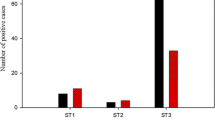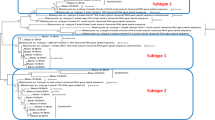Abstract
Despite years of study, the pathogenic role of Blastocytis hominis is still controversial. Genotypic differences between the asymptomatic and symptomatic isolates should assist in determining the pathogenicity of Blastocystis. In this study, we genotyped 32 Blastocystis isolates obtained from 12 asymptomatic healthy individuals and 20 symptomatic patients pain by polymerase chain reaction using known seven kinds of sequence tagged site primers in this study. When we compared genotype of Blastocystis isolates between the symptomatic and asymptomatic patient group, we found that subtype3 is the most dominant genotype in asymptomatic individual (9/12) and subtype1 determined all of symptomatic patients (20/20).


Similar content being viewed by others
References
Aksoy U, Erbay A, Akisu Ç, Apa H, Özkoç S, Öztürk S (2003) Intestinal parasites in children with neoplasms. Turk J Pediatr 45:129–132
Albrecht H, Stellbrink HJ, Koperski K, Greten H (1995) Blastocystis hominis in human immunodeficiency virus-related diarrhea. Scand J Gastroenterol 30:909–914
Boreham PF, Upcroft JA, Dunn LA (1992) Protein and DNA evidence for two demes of Blastocystis hominis from humans. Int J Parasitol 22:49–53
Clark CG (1997) Extensive genetic diversity in Blastocystis hominis. Mol Biochem Parasitol 87:79–83
Cruz Licea V, Plancarte Crespo A, Morán Álvarez C, Valencia Rojas S, Rodríguez Sánchez G, Vega Franco L (2003) Blastocystis hominis among food vendors in Xochimilco markets. Rev Latinoam Microbiol 45:12–15
Dogruman-Al DH, Yoshikawa H, Kurt Ö, Demirel M (2008) A possible link between subtype 2 and asymptomatic infections of Blastocystis hominis. Parasitol Res 103:685–689
Diaczok BJ, Rival J (1987) Diarrhea due to Blastocystis hominis: an old organism revisited. South Med J 80:931–932
Gregorio PC, María JR, María MG, Renzo AV, Franklin V, Ofelia C (2007) Finding of Blastocystis sp, in bivalves of the genus Donax. Rev Peru Biol 14(2):301–302
Hussein EM, Hussein AM, Eida MM, Atwa MM (2008) Pathophysiological variability of different genotypes of human Blastocystis hominis Egyptian isolates in experimentally infected rats. Parasitol Res 102:853–860
Init I, Foead AL, Fong MY, Yamazaki H, Rohela M, Yong HS, Mak JW (2007) Restriction enzyme digestion analysis of PCR-amplified DNA of Blastocystis hominis isolates. Southeast Asian J Trop Med Public Health 38:991–997
Kaneda Y, Horiki N, Cheng XJ, Fujita Y, Maruyama M, Tachibana H (2001) Ribodemes of Blastocystis hominis isolated in Japan. Am J Trop Med Hyg 65:393–396
Lanuza MD, Carbajal JA, Villar J, Mir A, Borras R (1999) Soluble protein and antigenic heterogeneity in axenic Blastocystis hominis isolates: pathogenic implications. Parasitol Res 85:93–97
Rivera WL, Tan MA (2005) Molecular characterization of Blastocystis isolates in the Philippines by ripoprinting. Parasitol Res 96:253–257
Snowden K, Logan K, Blozinski C, Hoevers J, Holman P (2000) Restriction-fragment-length polymorphism analysis of small-subunit rRNA genes of Blastocystis isolates from animal hosts. Parasitol Res 86:62–66
Stensvold CR, Suresh GK, Tan KS, Thompson RC, Traub RJ, Viscogliosi E, Yoshikawa H, Clark CG (2007) Terminology for Blastocystis subtypes—a consensus. Trends in Parasitol 23:93–96
Tan TC, Suresh KG, Smith HV (2008) Phenotypic and genotypic characterization of Blastocystis hominis isolates implicates subtype 3 as a subtype with pathogenic potential. Parasitol Res 104:85–93
Tasova Y, Şahin B, Koltas S, Paydas S (2000) Clinical significance and frequency of Blastocystis hominis in Turkish patients with hematological malignancy. Acta Med Okayama 54(3):133–136
Taamasri P, Leelayoova S, Rangsin R, Naaglor T, Ketupanya A, Mungthin M (2002) Prevalence of Blastocystis hominis carriage in Thai army personnel based in Chonburi, Thailand. Mil Med 167:643–646
Termmathurapoj S, Leelayoova S, Aimpun P, Thathaisong U, Nimmanon T, Taamasri P, Mungtin M (2004) The usefulness of short-term in vitro cultivation for the detection and molecular study of Blastocystis hominis in stool specimens. Parasitol Res 93:445–447
Thathaisong U, Worapong J, Mungthin M, Tan-Ariya P, Viputtigul K, Sudatis A, Noonai A, Leelayoova S (2003) Blastocystis isolates from a pig and a horse are closely related to Blastocystis hominis. J Clin Microbiol 41(3):967–975
Udkow MP, Markell EK (1993) Blastocystis hominis: prevalance in asymptomatic versus symptomatic hosts. J Infect Dis 168:242–244
Yan Y, Su S, Lai R, Liao H, Ye J, Li X, Luo X, Chen G (2006) Genetic variability of Blastocystis hominis isolates in China. Parasitol Res 99:597–601
Yoshikawa H, Nagano I, Yap EH, Singh M, Takahashi Y (1996) DNA polymorphism revealed by arbitrary primers polymerase chain reaction among Blastocystis strains isolated from humans, a chicken, and a reptile. J Eukaryot Microbiol 43:127–130
Yoshikawa H, Abe N, Iwasawa M, Kitano S, Nagano I, Wu Z, Takahashi Y (2000) Genomic analysis of Blastocystis hominis strains isolated from two long-term health care facilities. J Clin Microbiol 38:1324–1330
Yoshikawa H, Wu Z, Nagano I, Takahashi Y (2003) Molecular comparative studies among Blastocystis isolates obtained from humans and animals. J Parasitol 89:585–594
Yoshikawa H, Wu Z, Kimata I, Iseki M, Ali IK, Hossain MB, Zaman V, Haque R, Takahashi Y (2004) Polymerase chain reaction-based genotype classification among human Blastocystis hominis populations isolated from different countries. Parasitol Res 92:22–29
Wong KH, Ng GC, Lin RT, Yoshikawa H, Taylor MB, Tan KS (2008) Predominance of subtype 3 among Blastocystis isolates from a major hospital in Singapore. Parasitol Res 102:663–670
Acknowledgements
This study was supported by the Cukurova University Research Grant TF.2007.BAP.26.
Author information
Authors and Affiliations
Corresponding author
Rights and permissions
About this article
Cite this article
Eroglu, F., Genc, A., Elgun, G. et al. Identification of Blastocystis hominis isolates from asymptomatic and symptomatic patients by PCR. Parasitol Res 105, 1589–1592 (2009). https://doi.org/10.1007/s00436-009-1595-6
Received:
Accepted:
Published:
Issue Date:
DOI: https://doi.org/10.1007/s00436-009-1595-6




